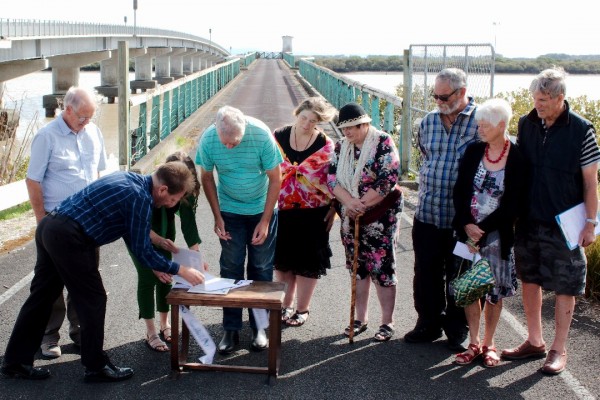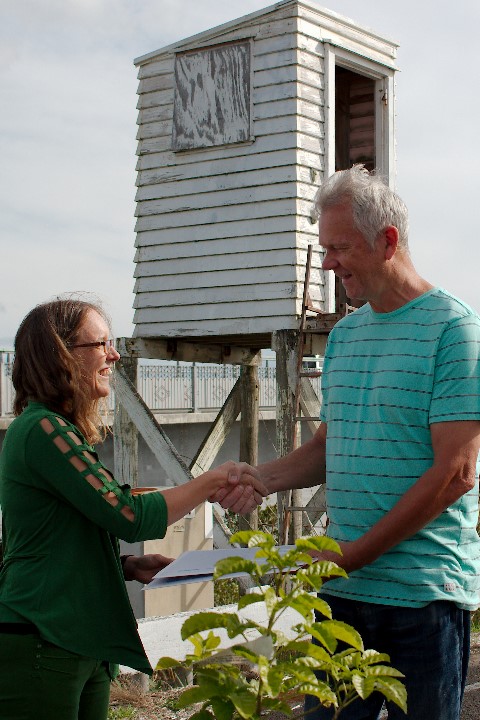Overview

Close up of the old Kopu bridge.
The ownership of the old single-lane Kopu Bridge near Thames has been passed to the Kopu Bridge and Community Trust. After several years of consultation and negotiations, the NZ Transport Agency signed an agreement in March 2018 for ownership of the heritage-listed bridge to be handed to the trust.
The central swing-span bridge across the Waihou River opened in 1928 and has been idle since the opening of the new two-lane Kopu Bridge in December 2011. As the bridge was no longer part of the national highway network the Transport Agency could no longer fund any future maintenance or upgrades.

Swing span at centre of old Kopu Bridge.
The deal is subject to the Transport Agency receiving yearly reports for five years from the trust on the operation of the bridge. The trust will also provide conservation, public health and safety, navigation of the Waihou River and engineering and maintenance plans.
If within the five years the trust indicates that it cannot manage the project, the Transport Agency can take back ownership of the bridge.

The signing of the document with from left to right, Barry Dowsett, Mark Ensor and Karen Boyt from NZTA with Ross Bayer signing on behalf of the Kopu Bridge and Community Trust. Then there are some of the Trustees, again left to right Kim Buchanan, Anne Stewart Ball, Wati Ngamane. Then Patron of the Trust, Jeanette Fitzsimons and; lastly Gary Blake from Historic Kopu Bridge Society.

NZTA Waikato Transport System Manager Karen Boyt and Ross Bayer from the Kopu Bridge and Community Trust.
Old Kopu Bridge timeline
- Click here the view the timeline
1928
Single-lane bridge with central swing span opens across Waihou River at Kopu. By the 1970s single-lane bridge leads to long queues at peak times
1974
Traffic signals installed
December 2011
A new two-lane bridge opens alongside the single lane one.
November 2012
Transport Agency hosts a public meeting in Thames to advise the local community about the process and options being considered for the old bridge.
September 2012
Formal expressions of interest called for the “adaptive re-use” of parts or sections of the old bridge.
February-March 2013
Public appeal for views – 69 per cent support for de-construction.
May 2013
Historic Kopu Bridge Society presents a business case to the Transport Agency to transfer ownership of the bridge to the society.
July 2013
Transport Agency rejects HKBS business case and announces bridge to be de-constructed.
August 2014
Thames-Coromandel poll shows 42.05% in favour of retaining the bridge and 52.95% against. When asked if ratepayers should contribute, 70% against.
2013/14
Historic Kopu Bridge Society continues to lobby for support and gains 2600 signatures to a petition to retain the bridge.
October 2014
Thames-Coromandel council decides it would support in principle the retention of the bridge, conditional on measures that eliminate the risk of future costs to ratepayers.
2015
Transport Agency engages an independent consultant with a background in historic structures and engineering to provide a report on the bridge.
Early 2016
HKBS invited to present a business case to take ownership of the bridge
May 2016
HKBS presents its business case to a panel of Transport Agency staff and independent experts. Unconvinced of financial position, panel extends time society until June 2016
2016-2017
Negotiations continue as both parties seek solution.
March 2018
Transport Agency and HKBS announce agreement for HKBS trust to take over ownership for term of 5 years, with management plans incorporated in the agreement.
Old Kopu Bridge frequently asked questions
- What has been agreed?
To vest ownership and maintenance the single-lane Kopu Bridge with the Historic Kopu Bridge Society trust for a period of five years.
Close
- What are the terms and conditions/timelines?
The trust will provide a yearly report to the Transport Agency for five years from the date of purchase on the trust’s operation of the bridge. Account for
- funding operation
- utilisation by public
- work programme
- actual works, in consideration of the technical requirements.
It will also provide various plans, including:
- Conservation Plan
A Conservation Plan covering the conservation, care and management of the bridge must be submitted to Heritage NZ within 6 months of handover and/or public operation of the bridge. - Public Health & Safety Plan
A Public Health & Safety Plan covering how the bridge will be operated and managed for public access must be completed within 6 months of handover but before any public operation of the bridge. - Engineering Maintenance Plan
An Engineering Maintenance and Management Plan covering all current needs and then potential future needs (eg for “deferred maintenance” such as structural painting for corrosion protection) must be completed and within 6 months of hand over and/or public operation of the bridg
- What if the trust cannot achieve these targets?
If the five-year undertaking by the trust is not successful the bridge may be returned to the Transport Agency.
Close
- What will be the impact on ratepayers?
None. The council/ratepayers will not own the bridge. It will be owned by the trust. The trust will use funding methods such as lottery grants, other grants, fundraising, donations and sponsorship etc to maintain the bridge and create a cycleway/walkway.
Close
- Why does ownership have to be transferred?
The Transport Agency cannot legitimately continue to fund any future maintenance or upgrade of the old bridge, because it is no longer part of the State Highway network.
Close
- What was that decision based on?
The HKBS has produced a business case showing its intention and methods for fundraising and a maintenance schedule.
Close
- What public consultation has been done?
Since the 2011 opening of the two-lane bridge at Kopu the Transport Agency has being considering what will happen to the disused, single-lane bridge which requires ongoing maintenance. The agency has engaged and consulted with:
- Local councils – both Thames-Coromandel and Hauraki district councils
- The New Zealand Historic Places Trust – now Heritage NZ
- General public – locally and nationally-viewed campaigns
- Historic Kopu Bridge Society
- An independent consultant was engaged by the Transport Agency to facilitate the consultation process and to ensure that all possible options for the bridge were impartially considered and thoroughly evaluated.
- What sort of support was there to retain the bridge?
A public campaign inviting feedback from the public about their views on the future of the bridge was undertaken by the Transport Agency during February and March 2013. The majority of submitters – 69% – supported de-construction. A poll by the Thames-Coromandel council in 2014 was also against keeping the bridge.
Close
- What were the options?
- To keep the bridge and open it up to the public, transferring ownership of the bridge to a trust/incorporated society
- Deconstruction the old bridge, but retaining the central swing arm and some other sections for a museum piece or re-use on the nearby cycleway for instance
- What is the cost to retain the bridge?
The Transport Agency has estimated that it would cost up to $2.3 million to upgrade the bridge to safely use it for walking and cycling, plus around $250,000 every year for maintenance. All of this funding will need to be raised by the HKBS.
Close
- What about the cost of deconstruction?
The option of deconstructing the bridge and retaining and relocating the swing arm, is estimated to cost about $3.9 million. This is something that the Transport Agency can fund, and all of these costs would be met by the Transport Agency.
Close
- Will boats still be able to use the waterway?
The trust will use a similar system as to the one used now which is that two days’ notice must be given to open the bridge for river traffic. The society and trust already have a team of trained operators who can open the bridge and will do so on request, with appropriate notice.
Close